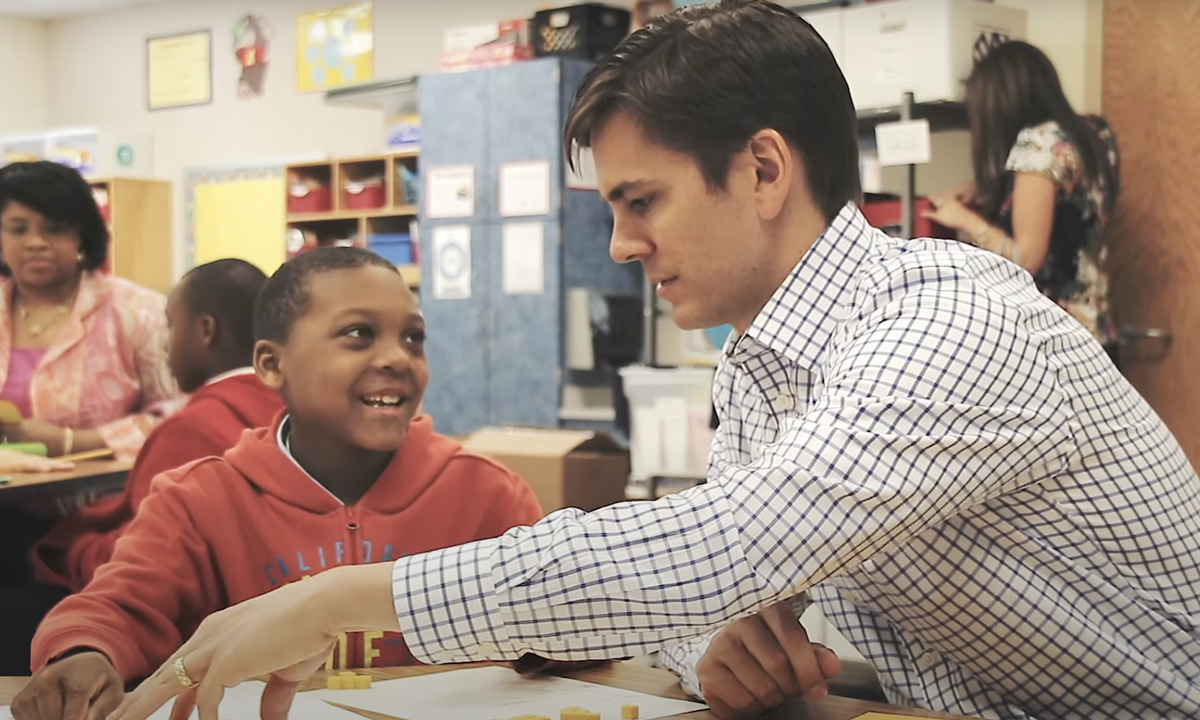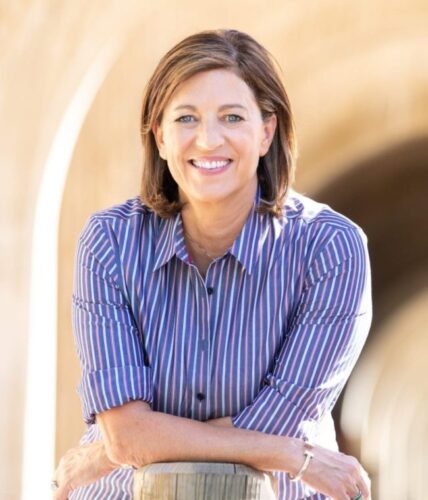Forget Memorization: A Concrete Understanding of Math Better for Young Learners
Heart Math Tutoring uses games and hands-on activities to make math less abstract, more real.

Get stories like this delivered straight to your inbox. Sign up for The 74 Newsletter
Emily Elliot Gaffney believes that many students enter kindergarten “without a lot of hands-on experience with numbers,” causing some to fall behind.
Without a foundational understanding of the relationship between numbers and quantities, Gaffney says, some students begin school “believing that math is almost a foreign language where they need to memorize answers to equations they’re seeing on the board.”
But to her, memorization is the wrong approach. Instead, she believes games and activities can help students recognize that the numbers in their lessons exist in real life. Once they make those connections, Gaffney thinks students will gain the understanding and confidence necessary to “figure out” basic math problems.
This way of thinking is what led her to help launch Heart Math Tutoring in 2013, which trains volunteer tutors to use toys and games to help students comprehend math.
Heart Math works with first through fifth graders in Charlotte, North Carolina, but has recently expanded to other nearby districts, including adding three South Carolina schools to its roster. This year, Heart is working with 26 schools in Charlotte.
Earlier this year, Heart received a $250,000 grant from the tutoring nonprofit Accelerate to expand their program. Accelerate previously told The 74 that Heart Math was selected for its use of volunteers, which can be a way to expand tutoring access.
Gaffney said “the Charlotte community has been extremely generous to fund the program” and donated “over $5 million” to public schools through Heart Math Tutoring.
To sign up, schools need to identify at least 50 students who are in need of math intervention. Heart Math Tutoring offers a year-long program, which costs about $75,000 per school to deliver, according to Gaffney. But Gaffney said that through agreements with partners, who offset those costs, some schools pay only 5% to 15 % of that amount.
When schools sign up for the year, Heart Math sends a dedicated staff member to their buildings four days a week for two hours a day. The program also brings a team of volunteers, who each come once a week for one of those hours. Heart’s staff member supervises and oversees all tutoring sessions, while tutors work one-on-one with students. Each student gets 30 minutes with a tutor twice per week.
Prior to starting the interventions, there is a month-long period of onboarding where the Heart Math employee assesses students’ math skills to figure out where they need help. Then, tutoring lasts for eight months. Afterwards, Heart Math reports back data and progress to schools.
Since officially launching 10 years ago, Heart Math Tutoring has served over 5,000 students. The program’s website states that 97% have met its target for academic growth. According to Heart’s annual report from September, last school year Heart served 1,072 students across 28 schools. Of those, 96% “showed growth on pre/post assessments.”
Charlotte-Mecklenburg Schools is one of Heart Math Tutoring’s oldest clients and has been working with the group for 13 years, prior to Heart establishing its own nonprofit in 2013. The district’s math specialists helped design the pilot version of Heart Math Tutoring in 2010, according to executive director of communications Susan Vernon-Devlin.
Vernon-Devlin said the 26 Charlotte-Mecklenburg schools that use Heart Math Tutoring “value both the academics and the one-on-one relationships that tutors build with our students.”
“Our schools consistently report positively about Heart Math Tutoring’s work with our students,” she wrote in an email. “Many teachers report that students return to class more confident, ready to help their peers, answer questions, and explain their thinking in math.”

Gaffney says Heart Math is “changing students’ beliefs about math, going from thinking that it’s something that has to be memorized to it’s something that they can figure out.”
From basic counting to multiplication and division, Heart Math puts students in charge of their own learning, Gaffney said.
“We train our tutors instructionally to make sure the student is the one doing the work, meaning the student is the one touching the materials, the student is the one doing most of the talking,” Gaffney said.
This year is Elizabeth Darden’s fourth volunteering for Heart. As a communications professional, Darden doesn’t consider herself a math expert, but she said that the training from Heart Math and the guidance from its on-site staff prepared her to get the job done.
“[Heart Math] makes it really easy for tutors because I mean, I think I’m decent at math, but definitely not in the math field or anything like that,” Darden said.
Logan Henderson, who has volunteered with Heart for 10 years and is also a “financial supporter,” agreed that “you don’t have to be a math expert” to be successful.
Darden said most of the activities she does during tutoring are “fun, interactive games,” which she says excites her students.
“It’s kind of a treat when a student gets called for Heart,” Darden said. “None of them see it as something negative or embarrassing, and they always jump right up and come in to play.”
Darden said the games build confidence in her students and help them visualize math concepts. Two years ago, one of her students started “really struggling” and fell behind his grade level, but by the end, he won an award in his class for “most improved.”
Henderson, who works in finance, said that Heart’s approach to teaching math is different from how he remembered learning math when he was in school, where the focus was on memorizing math facts like multiplication tables.
“When I was a kid, it seemed like the focus was on memorization,” Henderson said. “There’s been a recognition, I think, that, ‘Hey, there’s visual learners,’ right, some learn better visually.”
Gaffney said that some of Heart’s older students are “two-three years behind in elementary math.” These students often “lack a concrete understanding” of “what numerals really stand for,” which is why making visual connections is important..
“By the time they’ve gotten to us, someone has already told them before many times that three plus four equals seven, but when you show them a pile of seven cubes, and you cover up three cubes and they’re seeing four, they don’t know how many are hiding,” Gaffney said. “So telling them that three plus four is seven again is not going to fix it.”
To gain that understanding, students need activities that can help them visualize and comprehend math problems, including counting and arithmetic with objects, according to Gaffney.
“The important part is that they’re connecting numerals, abstract numerals, to concrete, hands-on things in the world,” Gaffney said.
The approach is supported by research.
Dionne Cross Francis, a professor of education at the University of North Carolina at Chapel Hill who specializes in math education, said most students enter kindergarten with “some concept of quantity” and “a desire to quantify things,” but that there is wide variation in their levels of understanding. If these problems are left unaddressed, students can have difficulty learning other concepts, as well, she said.
Cross Francis believes Heart Math has the right idea by emphasizing concrete activities early.
“Research would suggest that that’s where you start with children: that they actually have to be able to see one item and label it with the number-word one, and then continue to add additional items and label them with the appropriate number-word,” Cross Francis said. “We want to engage kids in really rich worthwhile experiences where they’re developing concepts from engagement with activities.”

Jo Boaler, an education professor at Stanford University and one of the author’s of California’s new math education framework, said that for too many students, learning math is a “completely abstract experience.”
Boaler thinks students should “connect more with numbers in the world” to build understanding, which she says is supported by research.
“What separates the high achievers is that they are able to look at numbers in different ways, break them apart, see numbers inside numbers,” Boaler said. “The low-achieving students are just trying to remember memorized facts.”
Disclosure: The Bill & Melinda Gates Foundation and the Overdeck Family Foundation provide financial support to Accelerate and The 74.
Get stories like these delivered straight to your inbox. Sign up for The 74 Newsletter

;)